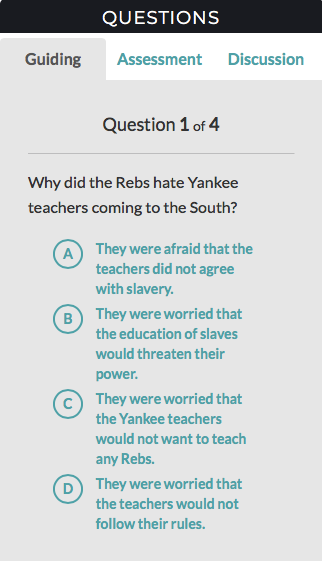The following list of perks is what has impressed most about Commonlit.org. It’s also what keeps me coming back to use it.
- Commonlit.org is user-friendly, and the relevant and rigorous readings the website provides are outstanding. They’re clear, organized, color-coded…need i say more?
- Commonlit.org has resources for grades 3-12, so it’s useful for nearly all grade levels.
- Commonlit.org is free, and by that, I don’t mean it’s “free for a year,” or “free if you don’t want the data.” It is free.
- Commonlit.org will work with most technology devices: Chromebooks, iPads, Macs, etc.
- Commonlit.org has all of its assignments in PDF format, just in case you have to print them (which is great for times when WiFi unexpectedly shuts down!).
And, most importantly, it improves student learning. Commonlit.org can help with differentiation, interdisciplinary integration, and rigorous reading and writing practice.
Differentiation
We hear this word so much as a teacher that I think we’ve become numb to the word. We go to the IEP (Individualized Education Program) meetings and get the documents from the EL (English Learner) teachers that list all the things we need to do to tailor our instruction to meet individual needs. In other words, we are expected to always have options built into our class for any student to receive support where and how they need it, whether by using visuals, having clear written directions (with pictures), or allowing peer tutoring. Commonlit.org provides your students with built-in support to match their abilities and learning styles with the materials and the skills.
Each assignment comes with this toolbar (on left). It includes a dictionary, audio recording of the text, translation of the word into various languages and a highlighter tool. There is also a related media tab which links to videos and images that are connected to the text or the theme of the text. The important part of this toolbar is that the students control the type of support they need for that text. They might only need one word translated and they can choose that. They may want to highlight a particular word or section. They might want to see a video related to what they are reading. They can get that, too. The toolbar puts the students in control of their differentiation.
I used this program in my Practical English course for seniors. Every one of my students had required accommodations and I wanted them to learn how to accommodate their learning styles by themselves, instead of me providing that for them. Students need to learn how to learn effectively. They need to learn how to read more than they need to simply read.
There are additional things that the teacher can choose to help with differentiation. Each reading is labeled with a grade level and a lexile number so you can pick the right piece for your students. You can also choose to turn on the “Guided Reading” option to an assignment. This setting forces the students to read one section at a time: it stops the student after certain sections and forces the student to answer questions about that section before they continue.
Interdisciplinary Integration
Commonlit.org is not an “English teacher resource” as much as it is a reading and writing resource. The website is designed to group the materials together by theme and text set, as well as by literary device and book supplementals. Therefore, a social studies teacher can find a text set about the Holocaust which would provide the students with a variety of media texts about that historical event. There could be a poem, article, interview and primary document all in the same text set. There are relevant articles, essays, speeches, etc. Materials are added every year that are relevant to students’ lives, interests and experience.
I teach for the Multimedia and Technology pathway. The students are grouped by similar interests so that they can be given experiences and education specific to that industry. Therefore, when I am teaching argumentative writing to my students, I make the conscious decision not to teach the same reading materials as everyone else. I go on Commonlit.org and find materials from varying perspectives on topics like the costs and benefits of technology. It connects what they are learning in English with their Career Technical Education.
Rigorous Reading and Writing Practice
It is essential that students learn how to read and write about complex texts. However, complex reading and writing practice take time to prepare and time to grade. On Commonlit.org, each of the texts have various question types that require critical thinking. For example, “How does the author’s discussion of George Orwell’s Nineteen Eighty-Four contribute to the text?” The next question will ask for students to find textual evidence that supports their answer.
It takes time for our students to get in the habit of thinking for themselves instead of looking for the right multiple choice answer. The rigor comes when we give them questions that provide opportunities for them to justify their thinking. The short answer questions take that rigor one step further by asking the students to write a complete paragraph with their evidence and analysis to support their answer. Commonlit.org offers example answers for each of those questions for the teachers to use when they score. Both the reading questions and the writing practice provide students with opportunity to express their thinking and learning.
How I Have Used CommonLit in my 11th Grade English Class
Just a few days after first having learned about CommonLit, I introduced this wonderful resource to the students in my 11th grade English class.
At the time, my students were engaged in a unit on oppression and reading Uncle Tom’s Children — a collection of short novels detailing the lives of black people in the Deep South during the post-slavery era and exploring their resistance to white racism and oppression. Originally published in 1938, Uncle Tom’s Children was the first book by Richard Wright, the author of the highly acclaimed novel Native Son.
To provide my students with a description of the difficulties African Americans faced during the slavery era, rather than after it, and to have my students learn how controlling literacy of others is a form of oppression, I directed my students to go to Commonlit.org and find the poem “Learning to Read.”
Very soon the Yankee teachers
Came down and set up school;
But, oh! how the Rebs did hate it,—
It was agin’ their rule.
Our masters always tried to hide
Book learning from our eyes;
Knowledge did’nt agree with slavery—
’Twould make us all too wise.
But some of us would try to steal
A little from the book.
And put the words together,
And learn by hook or crook.
I remember Uncle Caldwell,
Who took pot liquor fat
And greased the pages of his book,
And hid it in his hat.
And had his master ever seen
The leaves upon his head,
He’d have thought them greasy papers,
But nothing to be read.
And there was Mr. Turner’s Ben,
Who heard the children spell,
And picked the words right up by heart,
And learned to read ’em well.
Well, the Northern folks kept sending
The Yankee teachers down;
And they stood right up and helped us,
Though Rebs did sneer and frown.
And I longed to read my Bible,
For precious words it said;
But when I begun to learn it,
Folks just shook their heads,
And said there is no use trying,
Oh! Chloe, you’re too late;
But as I was rising sixty,
I had no time to wait.
So I got a pair of glasses,
And straight to work I went,
And never stopped till I could read
The hymns and Testament.
Then I got a little cabin
A place to call my own—
And I felt independent
As the queen upon her throne.
Even though the poem was only at the 5th grade reading level, the content and diction was unfamiliar to my students. We therefore used collaborative learning strategies to read through the poem together.
Then we watched the introductory video clip appearing on the CommonLit website (with this video accessible only to registered users).
I then let them work in groups to answer the Guided Reading questions.
[media-credit id=11278 align="aligncenter" width="350"] [/media-credit]
[/media-credit]
Then I had the groups share out and justify their answers with the text or resource that best supported their answers.
I then projected their answers onto a screen located at the front of the room and graded their answers on a score of 0-4 using a rubric that can be found by clicking here.
You should have seen me during the grading process. The entire time, I had on my “my-class-got-it” smile.
I then assigned another poem, “If We Must Die.” This one didn’t call for any short answers, but it did call for answers to several thought-provoking, evidence-based questions.
When the students first started to answer these questions, I was so confident that my students could ace it as well that I again plastered my “my-class-got-it” smile onto my face. Then I opened the results page and saw that the class average had dropped by 20 percent.
After evaluating the well-thought out and itemized data, I was able to identify two needs. My students could define words using context clues, but they couldn’t identify what evidence guided those context clues and they couldn’t follow simple instructions beyond choosing one multiple choice answer.
This is vital feedback for a teacher and certainly the perfect formative assessment for me. And what did I learn from it? Above all else, that though none of my students wanted to admit that they had a hard time transitioning from the traditional multiple choice question to more demanding thought-provoking evidence-based question, the data was clear. More than 50 percent of my students got the final “thought-provoking evidence-based question” at least partially wrong, in large part because they did not choose two statements as the question had prompted.
In any event, by the end of this unit on oppression, most of the students had a favorite poem, speech, interview or video that helped them form their answers to the essential question presented at the start of the question “What role does literature play in the area of pre- and post-American civil war oppression? “
Better yet, I watched a few students fall in love with reading.
Conclusion
Commonlit.org is anything but common. It is a powerful resource and you don’t have to believe me because I am an English teacher, but don’t disregard me just because I am an English teacher. Try it for yourself, especially if you are tired of jumping from one resource to another. You might just find the resource love of your life.

 [/media-credit]
[/media-credit]